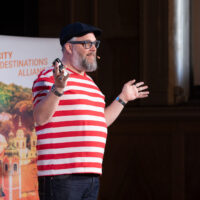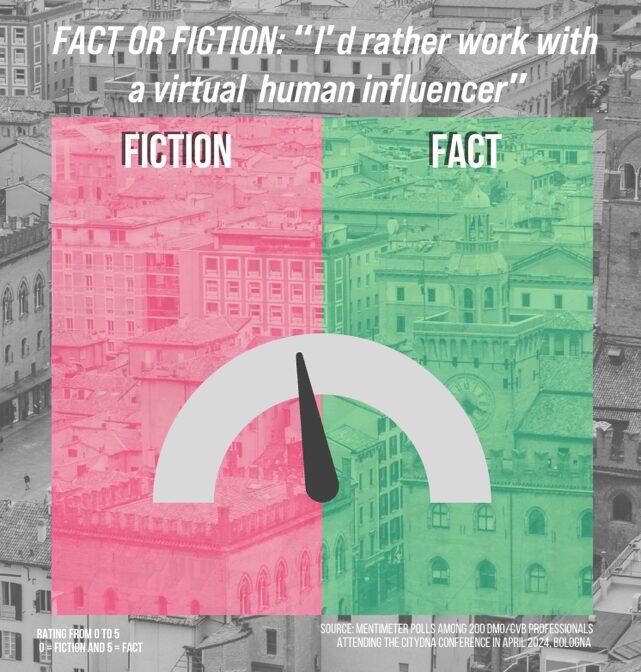Beauty or Beast: Are virtual influencers coming to a destination near you?

Photo credit: RAUWcc
IN CONVERSATION WITH MAARTEN REIJGERSBERG, RAUWcc, KEYNOTE SPEAKER AT CITYDNA INTERNATIONAL CONFERENCE IN BOLOGNA: ‘REALITY CHECK! ON FACT AND FICTION IN URBAN TOURISM’
Written in collaboration between City Destinations Alliance and Group NAO.

Should virtual influencers run wild in a destination? How does a virtual human represent a brand’s narrative, whilst also risk warping beauty standards? Is authenticity overrated? Maarten Reijgersberg thinks so. In an influencing world already saturated with fillers, filters, and fakeness, the rise of virtual influencers is arguably but a stone’s throw from our current reality. Maarten is the creator of the first virtual travel influencer, Esther Olofsson, a computer-generated fictional character (albeit partly based on Maarten’s own wife) used for branding-related purposes. The foundation for this article is both answered and unanswered questions from the highly engaged and rather divided audience during the #HUMANMADE session at the CityDNA International Conference. After the session on stage, we sat down with Maarten in a café in Bologna to understand the complex interplay between the digital authenticity that is transforming traditional city marketing.
How do people perceive Esther? You divided the room when you delivered your keynote, especially in relation to her appearance.
When we first created Esther, a lot of people found her scary. There is also this fear of being replaced, so therefore I say, let’s do more stuff that can’t be done with real humans. It’s also more fun to do so. It should be said that when we created Esther, we didn’t have in mind that we wanted to create the most beautiful woman in the world, we wanted to create her as most likeable. Yes, she’s beautiful, but she has her own identity, her own quirky look.
Still, quite a few in the room felt like Esther was inauthentic… Do you think Esther’s obviously “fake image” helps in distinguishing reality from digital fiction? In other words, is she more or less fake than ‘real influencers’?
Authenticity is overrated, every city image I’m looking at is photoshopped or filtered. I think Esther is more real than the ‘generic’ influencer. I don’t see a difference between heavily photoshopped images and virtual influencers, apart from with virtual influencers you can take control of the storytelling. There is a good example in the Netherlands as the ALDI supermarket chain replaced a former voice-over actor with an AI-generated voice. But in this voice, ALDI mixed recordings from eight of their employees to create a single, unified AI voice that now represents the brand. These are employees working in the warehouse, marketing, cash registers etc. Isn’t this more authentic than using one voice-over actor?
Do you think there is a human ‘rawness’ lost when using AI to create Esther? Can she really put across the authenticity of a place?
I don’t think so. I think with the first version of Esther, we were able to do things that the municipality and Rotterdam partners never were able to do. Sure, we could make Esther into a cubistic style Picasso woman. Then you wouldn’t get distracted by her appearance and she’d still promote the story of “that bar”. Maybe this is worth exploring. But Esther can travel in time, in more places at the same time, can dive deep into the history of the city. By creating a virtual persona for the promotion of your city, you should not be looking for a copy of what we already have, or what real life people can do, you should dive into all the other possibilities you have with a virtual persona. And she can speak 56 different languages…
What advice would you give a destination looking to create their own virtual influencer?
I would say it is well worth a destination creating their own virtual persona, over hiring an influencer. For example, a DMO could create the ultimate Bolognesi virtual persona by cherry picking a variety of people already living in the city and merge them to embody the destination. Esther’s account at one point was a travel-focused platform, allowing her to explore and share experiences from places like Copenhagen and Malmo, mirroring what real-life influencers do when they travel. That was all fun but promoting her as a travel influencer wasn’t commercially viable for us since it remained a pet project. Transitioning her role to that of a virtual brand ambassador was more aligned with our agency’s goals and resources because we are a creative agency and Esther is our playground.

Do you think we should always say when something has been virtually created? What advice would you give to DMOs who are repurposing content by using DALL-E etc?
I’m a bit in doubt here. Our agency is part of a wider network discussing whether we should use the #GenAI hashtag with every AI generated image. It’s up for debate because we never did this with photoshopped images. So why does it work differently with generated images? I do however think we should speak out more often, for example in the profile text of Esther Olofsson, it’s very clearly stated she isn’t real. I doubt the #GenAI hashtag will be effective. I think people would just turn a blind eye.
In your keynote, you mentioned how AI inappropriately altered Esther’s image during her visit to Brazil by enlarging her breast size, which you openly criticised. How can more transparency be integrated into designing virtual humans?
I actually wanted the image to be posted, but I wanted to have a transparent line about it. Every now and then we make jokes about Esther, like she has too many fingers, we put the AI mistakes out in the open – to show a bit of vulnerability about the state of AI right now – and I would love to do more of that. It should also be said that everybody who works with technology and data, should have a reasonable amount of knowledge. My parents were art dealers in Middle Ages and Renaissance art, so I always try to look back and learn from the past. We’re in a new technological revolution with AI, but when the steam engine was developed, ethics were thrown away and there was no care for the environment. And it was in the name of growth and innovation. Now we have more knowledge to ethically approach these technologies. We need our decision makers to put their foot down more, for example, to only build climate neutral data centres.
What’s key in making the virtual influencing industry one you would be prouder of?
The first thing we should do is make every prompt master realise they are in charge of the bias that is being thrown out there. If DALL-E makes a “perfect” image of a CEO, which is a middle-aged white man, then it is the responsibility of the prompt master to not use that. This isn’t the responsibility of ‘AI’. It has been trained by us for so many years on awful imagery and bias. We need to enhance and expand the education of prompt masters.
We also shouldn’t be afraid to make mistakes. The great thing about a virtual character is that you can continually change it. In my presentation there is a video of Esther in my office, and in this video, she is very thin. I know in my keynote; this is where things went south and the audience didn’t like that. I don’t like that. I was not involved in the making of that image. But I take it upon myself that I should be more in control of every picture that is created of Esther. Or if I can’t be in control, I need to make sure my colleagues set a standard for every picture. It is on us.